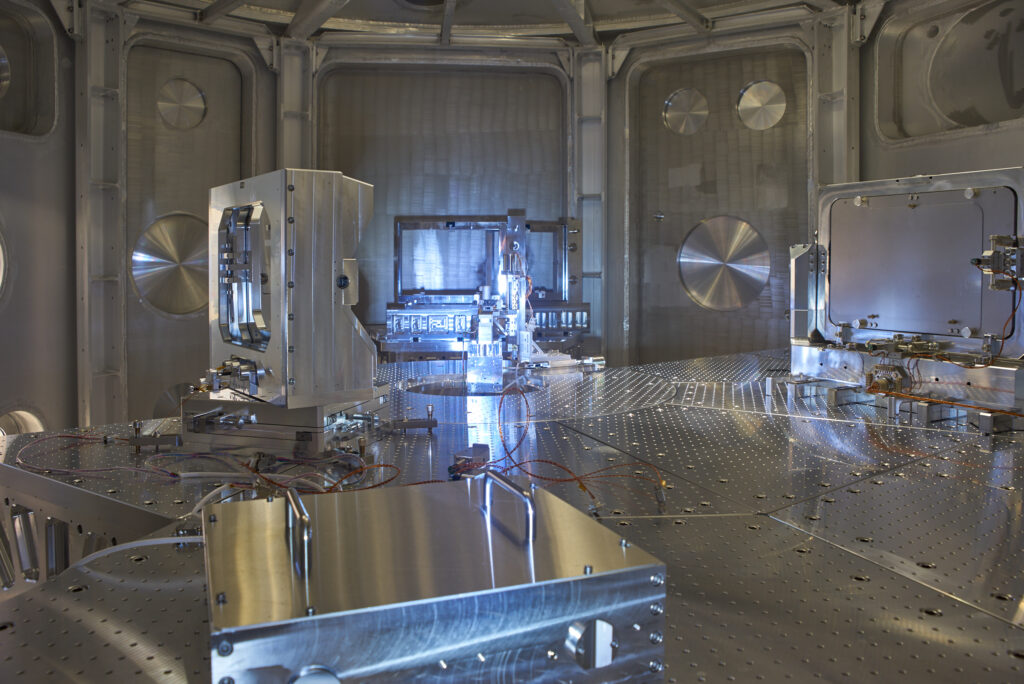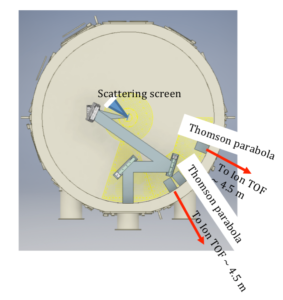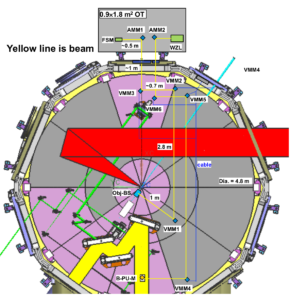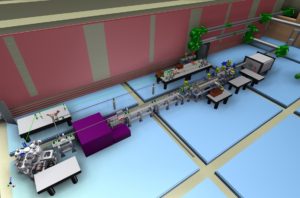P3 features a unique infrastructure that includes the following:
- Up to 5 synchronized laser beams (initially ~ps; later ~fs level)
- High repetition rate lasers (10 Hz and 1 Hz)
- High intensity (10 PW) as well as high energy (kJ) operation
- A large versatile vacuum chamber (~45 m3)
- A pulsed power device for magnetic field generation (>50 Tesla)
- A Betatron for diagnostic purposes
- A plasma mirror chamber for contrast enhancement
- An optical switchyard and manipulation station (MOB) including delay lines, frequency conversion, leakage optics for pulse characterization, adaptive optics, etc.
P3 is oriented towards fundamental research applications that do not involve any predefined secondary sources. This chamber accommodates the ELI lasers L2, L3, and L4. L4 is provided with a flexible energy partition between L4n (nanosecond-scale), L4f (femtosecond-scale), and L4p (picosecond-scale).

What the users get:
Initially the experimental hall E3 will provide two fundamental experimental configurations in the P3 infrastructure:
- a short-focal length setup for experiments related to X-rays and ions
- a long-focal length setup for experiments related to electrons
Basic diagnostics for plasma and laser beam characterization will be available.

Short focal-length setup (SFL)
The L3 laser beam 10 J, 30 fs, 3 Hz can be focused to a focal spot size of 5 mm FWHM using a gold coated f/#3 OAP available at the facility. The current setup can provide focused intensities of about 5 x 1021 W/cm2. Targets can be mounted on a XYZ translation stage and a rotation stage. The minimum angle of incidence on the solid target is limited to 15 degrees. If a port is desired in the direction of target normal, then the angle of incidence is limited to either 18 degrees or 53 degrees. A set of visible, electron, ion and X-ray detectors will be available to characterize the interaction. The setup is reported in Fig. 5.

Figure 5: Optical layout of the short focal length experiments showing location of some diagnostics at target normal (two options).
Targets
Solid targets can either be shot as individual foils assembled on a rastor or in the form of tape delivery system. The current configuration of the tape system can provide a position accuracy of ± 2 μm. The tape delivery system is design to dispense tape targets of 2 cm width and thickness in the range of 5 μm to 50 μm.
Long focal-length setup (LFL)
We can provide the long focusing setup for L3 laser, using a gold coated spherical mirror with focal length of 5 m. For the first phase of user experiment, we will provide electron from laser wakefield acceleration (LWFA) and related radiation, especially betatron radiation, inverse Compton radiation. A set of electron and X-ray diagnostics will be available to characterize the electron and X-ray beam. A second laser beam (40 mm) would be available which is synchronized with L3 laser. It can be used for plasma probing (shadowgraphy/interferometry) or pump-probe experiment with the betatron X-ray beam. The setup is reported in Fig. 6:

Figure 6: Beam transport and focusing for long focal length regime.
Parameters of Secondary Source
Table 1. Expected electron and X-ray source parameter in E3.
| Electron | X-rays (Betatron and ICS) | ||||||
| Energy (GeV) | No. of e- | Charge (pC) | div. (mrad) | ECrit. | flux/shot | div. (mrad) | Duration (fs) |
| 0.2 – 1.5 | 109 | 10- 400 | 10 | few keV- MeV | 109 | 20 | <10 |
Targets
High density and low-density gas nozzles system can be provided, or user can come with their own gas nozzles that are compatible with Parker Valve. Compressed gas bottles (H2, He, He+N2, O2, dry air, Ar, Kr and limited Xe) will be provided.
| Target | Mnf. Part nr. | Specs. |
| High density gas jet | Built in-house | Pressure ≤ 1000 bar. Gas density ≤ 3.5 x 21 atoms/cm3. Some nozzles are available. |
| Low density gas jet | Parker | Pressure ≤ 86.2bar. Iota One Pulse Driver System. Nozzles designed in-house. |
Senior scientists responsible for P3:
Stefan WEBER, stefan.weber@eli-beams.eu






